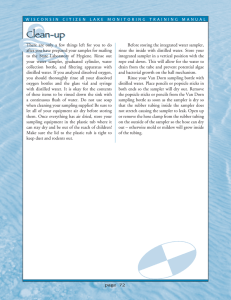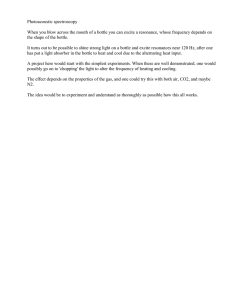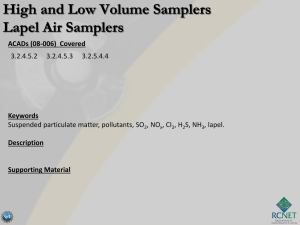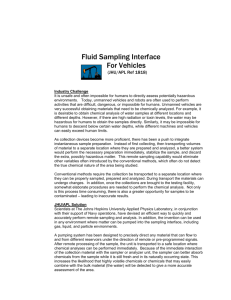An environmentally driven time-integrating water sampler
advertisement
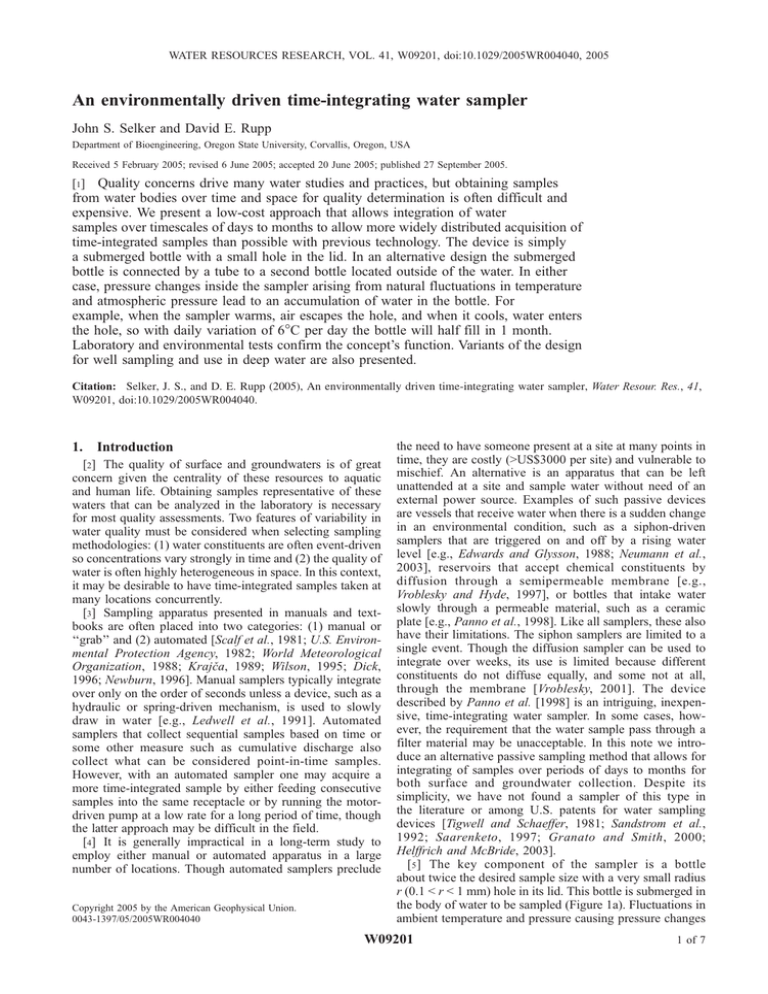
WATER RESOURCES RESEARCH, VOL. 41, W09201, doi:10.1029/2005WR004040, 2005 An environmentally driven time-integrating water sampler John S. Selker and David E. Rupp Department of Bioengineering, Oregon State University, Corvallis, Oregon, USA Received 5 February 2005; revised 6 June 2005; accepted 20 June 2005; published 27 September 2005. [1] Quality concerns drive many water studies and practices, but obtaining samples from water bodies over time and space for quality determination is often difficult and expensive. We present a low-cost approach that allows integration of water samples over timescales of days to months to allow more widely distributed acquisition of time-integrated samples than possible with previous technology. The device is simply a submerged bottle with a small hole in the lid. In an alternative design the submerged bottle is connected by a tube to a second bottle located outside of the water. In either case, pressure changes inside the sampler arising from natural fluctuations in temperature and atmospheric pressure lead to an accumulation of water in the bottle. For example, when the sampler warms, air escapes the hole, and when it cools, water enters the hole, so with daily variation of 6C per day the bottle will half fill in 1 month. Laboratory and environmental tests confirm the concept’s function. Variants of the design for well sampling and use in deep water are also presented. Citation: Selker, J. S., and D. E. Rupp (2005), An environmentally driven time-integrating water sampler, Water Resour. Res., 41, W09201, doi:10.1029/2005WR004040. 1. Introduction [2] The quality of surface and groundwaters is of great concern given the centrality of these resources to aquatic and human life. Obtaining samples representative of these waters that can be analyzed in the laboratory is necessary for most quality assessments. Two features of variability in water quality must be considered when selecting sampling methodologies: (1) water constituents are often event-driven so concentrations vary strongly in time and (2) the quality of water is often highly heterogeneous in space. In this context, it may be desirable to have time-integrated samples taken at many locations concurrently. [3] Sampling apparatus presented in manuals and textbooks are often placed into two categories: (1) manual or ‘‘grab’’ and (2) automated [Scalf et al., 1981; U.S. Environmental Protection Agency, 1982; World Meteorological Organization, 1988; Krajča, 1989; Wilson, 1995; Dick, 1996; Newburn, 1996]. Manual samplers typically integrate over only on the order of seconds unless a device, such as a hydraulic or spring-driven mechanism, is used to slowly draw in water [e.g., Ledwell et al., 1991]. Automated samplers that collect sequential samples based on time or some other measure such as cumulative discharge also collect what can be considered point-in-time samples. However, with an automated sampler one may acquire a more time-integrated sample by either feeding consecutive samples into the same receptacle or by running the motordriven pump at a low rate for a long period of time, though the latter approach may be difficult in the field. [4] It is generally impractical in a long-term study to employ either manual or automated apparatus in a large number of locations. Though automated samplers preclude Copyright 2005 by the American Geophysical Union. 0043-1397/05/2005WR004040 the need to have someone present at a site at many points in time, they are costly (>US$3000 per site) and vulnerable to mischief. An alternative is an apparatus that can be left unattended at a site and sample water without need of an external power source. Examples of such passive devices are vessels that receive water when there is a sudden change in an environmental condition, such as a siphon-driven samplers that are triggered on and off by a rising water level [e.g., Edwards and Glysson, 1988; Neumann et al., 2003], reservoirs that accept chemical constituents by diffusion through a semipermeable membrane [e.g., Vroblesky and Hyde, 1997], or bottles that intake water slowly through a permeable material, such as a ceramic plate [e.g., Panno et al., 1998]. Like all samplers, these also have their limitations. The siphon samplers are limited to a single event. Though the diffusion sampler can be used to integrate over weeks, its use is limited because different constituents do not diffuse equally, and some not at all, through the membrane [Vroblesky, 2001]. The device described by Panno et al. [1998] is an intriguing, inexpensive, time-integrating water sampler. In some cases, however, the requirement that the water sample pass through a filter material may be unacceptable. In this note we introduce an alternative passive sampling method that allows for integrating of samples over periods of days to months for both surface and groundwater collection. Despite its simplicity, we have not found a sampler of this type in the literature or among U.S. patents for water sampling devices [Tigwell and Schaeffer, 1981; Sandstrom et al., 1992; Saarenketo, 1997; Granato and Smith, 2000; Helffrich and McBride, 2003]. [5 ] The key component of the sampler is a bottle about twice the desired sample size with a very small radius r (0.1 < r < 1 mm) hole in its lid. This bottle is submerged in the body of water to be sampled (Figure 1a). Fluctuations in ambient temperature and pressure causing pressure changes W09201 1 of 7 W09201 SELKER AND RUPP: RAPID COMMUNICATION W09201 of 3 to 7 days due to atmospheric circulation will also be important. Water level fluctuations may also be a factor if the sampler is fixed in space. [7] At any given time, the gas phase in the sampler with air volume V will closely follow the ideal gas law PV ¼ nRT ð1Þ where P is pressure, T is temperature, n is the molar mass of the air, and R is the universal gas constant. If the ratio of temperature over pressure in the sampler decreases, the corresponding contraction of air in the bottle DV can be calculated as DV ¼ nRDðT =PÞ; DðT =PÞ < 0 ð2Þ Because the sampler volume is rigid, a volume of water equivalent to DV will enter the small hole in the lid to occupy the vacuum created. Conversely, if D(T/P) increases, the corresponding expansion of the gas will result in a mass of air Dn leaving the bottle through the hole: Dn ¼ RV DðT =PÞ; DðT =PÞ > 0 ð3Þ Figure 1. Schematic of (a) single- and (b) dual-bottle water samplers. An optional temperature logger may be located inside the submerged bottle (single-bottle sampler) or unsubmerged bottle (dual-bottle sampler) for estimating the timing and magnitude of sampling events. [8] Assuming for the moment that the resistance to air or water passage through the hole is insignificant, we can easily predict how much water the sampler will acquire over time. Let us suppose that the bottle is located in a shallow, exposed body of water such that daily temperature swings are the primary driver of the sampler. Between day and night the volume of gas will contract by an amount within the bottle lead to an accumulation of water in the sampler. In settings where water temperatures vary little, a second bottle located outside of the water body can be connected by a tube to the submerged bottle (Figure 1b). The second bottle serves as the primary sampler pump because it is subjected to greater temperature fluctuations. Though not an operational requirement, a small temperature recorder may be suspended in the sampler air volume to record the timing and magnitude of temperature swings that drive sampling. Also, atmospheric pressure fluctuations may be monitored locally, but in many locations the atmospheric pressure recorded at nearby weather stations is sufficient. After describing the basic requirements of the sampler and experimental results, we discuss potential limitations and variants on the implementation of the device for particular applications. DV ¼ ðT =PÞH ðT =PÞL nH R 2. Theory [6] The simple sampler described above is driven by physical environmental changes found in most surface waters. When the pressure outside the bottle is less than the pressure in the bottle, the air in the bottle expands and air escapes, whereas when the outside pressure exceeds the internal bottle pressure, the air contracts, allowing water to enter. Physical processes that control the relative pressure between the bottle and overlying water are air temperature in the bottle and atmospheric pressure fluctuations. Though diurnal temperature changes in the water will be the dominant forcing mechanisms in many settings, external pressure swings of commonly 10 to 40 cm H20 with periods ð4Þ where the subscripts H and L refer to the warmest and coldest times of the day, respectively. The fractional volumetric change, x, is simply given by VH VL DðT =PÞ ¼ ¼x VH ðT =PÞH ð5Þ Using typical values, if the mean stream temperature is 280K, the mean pressure is mean sea level pressure or 1033 cm H20, and the diurnal temperature variation is 6K (or there is a diurnal change D(T/P) of comparable effect), then the daily decrease in gas volume will be 2.2%, which will be accommodated by an influx of water through the small hole in the lid. The filling of the sampler volume V0 will decrease exponentially as days pass due to the loss of volume of gas in the bottle, so that after m days the remaining gas filled volume will be Vm ¼ ð1 xÞm Vo ð6Þ Following 32 days of operation at the environmental conditions given above, the bottle would be half filled with water. The sample would be made up of 32 additions, which were half as large on the final day as the initial day. In practice the water must overcome capillary resistance to pass through the small intake hole, which is discussed in detail below. 2 of 7 SELKER AND RUPP: RAPID COMMUNICATION W09201 [9] In settings where short-term (e.g., daily) water temperature changes are small, the dual-bottle sampler described earlier can be used to take advantage of the larger air temperature fluctuations. The above discussion still applies exactly, with the caveat that the sampler volume V0 is the sum of the volumes of the submerged and nonsubmerged bottles. [10] Beyond the size of the bottle, the only significant design consideration for this device is the size of the aperture to put in the lid. If the hole is far too large air could escape while water entered. This would require a hole of radius greater than 5 mm (which can be shown by computing buoyant versus capillary forces of bubbles). However, if the hole is too small, the pressure built up within the bottle by the temperature increase or the pressure occurring drop outside the bottle will be insufficient to force air out the hole. We recall that the pressure to be exceeded to force air through a circular aperture of radius r is well described by the equation [see, e.g., Selker et al., 1999] P¼ 2s r ð7Þ where s is the air-water interfacial energy, or surface tension. [11] What pressures should we expect to generate in the bottle? Again appealing to the ideal gas law, it is straightforward to compute the pressure which would result from a small temperature change in a bottle from which gas could not escape. Solving (1) for P/T we find this to be a constant of the system P Rn ¼ T V ð8Þ For example, a deviation of 5K from 280K would change the pressure by about 1.8% of the original pressure, or approximately 0.02 ATM. [12] Supposing that we would like the unit to release gas with temperature or pressure changes of this magnitude, we may compute the required hole radius using (7). Here we take the surface tension of water to be 72 dynes/cm, or 7.1 105 ATM mm, yielding a constraint that the radius should be 0.07 mm or larger to allow air to escape following a 0.02 ATM change. A US standard number 80 drill, typically the smallest drill in a machinist’s set, has a radius of 0.17 mm, which would allow air to exit due to even smaller environmental fluctuations (0.008 ATM or about 2K). [13] An additional consideration in choosing the hole size is that we would like to avoid collecting water from periodic slight changes in water elevation (e.g., surface waves; slight bobbing of the device if suspended in a buoy). From considerations of capillary hysteresis, the bottle will not sample if the pressure swings provide less change in pressure than the critical pressure computed above from (7). Supposing that we would like the bottle to be able to resist collecting water with water elevation changes of 50 mm, this is an equivalent pressure change of 0.005 ATM, indicating a hole radius smaller than 0.3 mm. The number 80 drill would resist collecting water with shifts of water depth to about 85 mm, which would be adequate W09201 for many applications. These calculations constrain the hole for this particular case to be 0.1 mm < r < 0.3 mm, within which the smallest drill in a machinist’s set conveniently falls. [14] Consideration of the actual capillary resistance of the sampler intake hole and the full range of environmental temperature and pressure changes occurring over the course of several weeks requires adjustments to the predictions of water accumulation given by (5) and (6). In order to predict sample volumes based on intake hole size and observed temporal variability in the environment, the water and gas transfer through the hole can be computed by balancing the internal bottle pressure Pb with the pressure of the environment Pe through time: Pe ¼ Pb þ Pc ; jPc j Pentry ð9Þ where Pc is the pressure difference across the curved interface between the air and water in the intake hole and Pentry is the pressure required to overcome the resistance to water or air passage through the intake hole. Pe is the measured pressure due to the atmosphere and the water depth above the hole. The bottle pressure Pb is calculated by (1) from the measured bottle temperature Tb. [15] As the difference between Pe and Pb increases, Pc also increases to maintain the balance in (9). If, however, Pc reaches or exceeds Pentry, (position b in Figure 2), air leaves the sampler and the air-water interface relaxes to the degree that Pc equals Pair, the ‘‘relaxation’’ pressure following air release (position c in Figure 2). Pb is then recalculated from (9) with the new value of Pc, and n is updated from (1). [16] Conversely, as the difference between Pe and Pb decreases, Pc is allowed to decrease to the point that jPcj reaches or exceeds Pentry, (position d in Figure 2). At this point water enters the sampler and the air-water interface relaxes to the degree that Pc equals Pwat, the relaxation pressure following water entry (position e in Figure 2). Pb is then recalculated from (9) with the new value of Pc, and V is updated from (1). [17] The model can be used with daily or subdaily measurements of Tb and Pe. The sampler parameters Pentry, Pair and Pwat are determined experimentally (see below). 3. Materials and Methods [18] Laboratory and ‘‘field’’ experiments were conducted to compare sampler performance against prediction. The first set of experiments determined the values of Pentry, Pair and Pwat. These values were compared to theoretical prediction of entry pressure from (7). In the second set of experiments, a 7-week sampling run was conducted where samplers were subjected to real environmental fluctuations to compare actual against predicted water accumulation with time. [19] The water sampler was tested in the laboratory to determine the pressure Pentry required to overcome the resistance to water and air entry through the sampler’s intake hole. The sampler consists of a 615 ml rubber-coated clear glass bottle with a plastic screw cap into which was drilled a small intake hole (Figure 1a). A vertical column of water sealed to the cap was positioned above the hole. The water height h in the column was increased until water entered the bottle (hwat) and lowered until air escaped the 3 of 7 W09201 SELKER AND RUPP: RAPID COMMUNICATION W09201 original samplers. The sampler consisted of two bottles connected via a flexible plastic tube (Figure 1b). The bottle containing the small intake hole was located in the bucket of water while the second bottle, which was otherwise sealed, was placed outside of the water. A small thermometer was placed inside the outside bottle. 4. Results and Discussion Figure 2. (top) Illustration of air/water interface at various states of the system and (bottom) an example of the pressures at these states as determined by a laboratory experiment. Figure 2 (top) shows a blowup of the intake hole and the air/water interfaces (dashed lines) at five states: a, Pe = Pb; b, Pe = Pb Pentry; c, Pe = Pb Pair; d, Pe = Pb + Pentry; e, Pe = Pb + Pwat. Pe is the external pressure at the hole, Pb is the pressure inside the bottle at the hole, and Pentry is the pressure difference across the curved air/ water interface at which air will escape the bottle or water will enter the bottle. After air bubbles escape the bottle, the system relaxes at a pressure difference across the interface equal to Pair. Similarly, after water drops enter the bottle, the system relaxes at a pressure difference across the interface equal to Pwat. bottle (hair). The process was repeated at least seven times for each of three holes made with US standard number 70, 75, and 79 drills, which have radii of 0.356 mm, 0.267 mm, and 0.184 mm, respectively. [20] Three single-bottle samplers, each with different size holes, were placed in a bucket of water on the campus of Oregon State University, Corvallis, Oregon, for approximately 7 weeks (19 November 2003 to 6 January 2004). The holes were made with number 70, 75, and 79 drills. A metal weight was secured to each bottle to ensure that they sank to the bottom of the bucket. A small thermometer (Kooltrack standard temperature logger 214002) in the air volume of the sampler (attached to the underside of the cap) recorded temperature hourly. Atmospheric pressure measurements recorded every twenty minutes at the Corvallis Municipal Airport were acquired from the U.S. National Weather Service. The atmospheric pressure values were evaluated at each hour by a linear interpolation to correspond to the hourly temperature observations. The bottles were weighed approximately every 7 days. [21] On day 29 of the bucket experiment, a dual-bottle sampler with a 70 drilled hole was placed next to the three 4.1. Experimental Results [22] From the laboratory experiment, the pressure required to force air exit or water entry was calculated as Pentry = jhwat hairj/2, assuming symmetry between the air and water entry pressures. The average values of Pentry from all repetitions for the holes made with drills 70, 75, and 79 were 2.0, 3.4, and 7.0 cm H20, respectively (Table 1). These values are all less than P calculated from (5) (Table 1), which is expected as the holes have radii larger than the radii of the drills. The differences between hwat and hair were consistent among repetitions for the same hole radius. Also consistently observed was a drop in water height Dhwat to a static level following the onset of water entry (1.7, 1.9 and 1.0 cm, for drills 70, 75 and 79, respectively) and a rise in water level Dhair following air escape (0.8, 1.0, and 0.7 cm, for drills 70, 75, and 79, respectively). An example of this phenomenon is illustrated in Figure 2, which shows the water height at various stages of one experiment. From these selfadjustments to the column height immediately following air and water entry, we calculated Pair = Pentry jDhairj and Pwat = Pentry jDhwatj (Table 1). [23] Over 7 weeks, the three single-bottle samplers in the bucket of water collected 38%, 18%, and 13% of the total bottle volume corresponding to drills 70, 75, and 79, respectively (Figure 3). In 3/7 of the time, the dual-bottle sampler accumulated 33% of volume of the sampling bottle, or 17% of the total sampler volume (x2 bottles), which is similar to the sampling rate of the single-bottle sampler with the same hole size. We expected the dual-bottle sampler to collect more water than the single-bottle sampler because of expected larger air temperature fluctuations. However, during this cold, generally overcast 3-week period the air and water temperatures did not differ greatly (Figure 4). [24] We predicted the amount of water collected by the samplers from the bottle temperature and atmospheric pressure data shown in Figure 4. Though the temperature forcing is greater than the pressure forcing under these conditions, their effect is of the same magnitude (Figure 5). In the case of the largest intake hole (70 drill), the predicted and observed weekly increases in water volume were generally proportional, though the predicted volume after 7 weeks was 83% of the observed volume (Figure 3). This suggests Table 1. Predicted and Observed Capillary Pressures for Three Hole Sizes U.S. Standard Drill Drill r, mm 2s/r, cm Pentry, cm H2O Pair, cm H2O Pwat, cm H2O DT,a C 70 75 79 0.356 0.267 0.184 4.2 5.6 8.1 2.0 3.4 7.0 1.2 2.4 6.3 0.3 1.5 6.0 0.54 0.92 1.90 4 of 7 a Theoretical temperature change required to achieve Pentry. W09201 SELKER AND RUPP: RAPID COMMUNICATION W09201 amounts were generally proportional, suggesting that for this sampler the predicted entry pressures were too small. In the case of the smallest intake hole (79 drill), we also overpredicted the water intake, though after the first 5 weeks the discrepancy was only 3%. Inexplicably, this sampler collected almost no water during the final 2 weeks of the experiment. Note that the bottle caps used in the bucket tests were not the same caps that were used in the laboratory tests to determine entry pressures. Though the drill bits used to make the holes were identical, the holes may have been slightly different in size. [25] These tests were conducted in the winter, when the outside temperatures were much lower than the laboratory conditions where the samplers were prepared for use. It is apparent that upon initiation of the tests a much larger amount of water was collected than during subsequent time periods (Figure 3). This was due to the contraction of the air from laboratory temperature to ambient outside temperature (Figure 4). In practice it is preferable to start the bottles at lower than water temperature so that as they reach equilibrium they eject air rather than draw in water. This suggests storing the bottles on ice prior to installation. Figure 3. Observed (symbols) and predicted (lines) water accumulation with time for samplers with three differently sized intake holes. Predicted values are based on air/water entry pressures of 2.0, 3.4, and 7.0 cm as derived from laboratory experiments (see text). that the predicted entry pressures used in the model were slightly high. Conversely, the predicted amount for the middle-sized hole (75 drill) was substantially higher than the observed amount, yet again the predicted and observed 4.2. Limitations, Bias, and Variants on the Design [26] There are several issues that may be important to obtaining a quality sample that have not yet been addressed. One issue is the stability of the sample in the time over which it is integrated. However, two advantages of the sampler over most automated samplers are that the sample remains at ambient temperatures and that the sample is not directly exposed to the atmosphere during the sampling period. For example, it has been shown using another type of sampler with a similarly submerged sampler bottle that stream water collected gradually over a month-long period showed little change in nonvolatile chemical composition [Panno et al., 1998]. One potentially important difference is that with our sampler water enters through an approximately 0.2 mm radius hole, whereas the samples in the study of Panno et al. [1998] passed through a ceramic plate with a pores size of 6 mm (still large enough to pass some microbes). Where stability is an issue, we observe that the bottle may be prepared in a number of ways that may be helpful: it could be filled with an inert gas; dosed with a Figure 4. Observed hourly bottle temperatures T and observed hourly atmospheric pressure Pe during experiment. 5 of 7 W09201 SELKER AND RUPP: RAPID COMMUNICATION Figure 5. Maximum predicted water accumulation with time based on observed hourly internal bottle temperature T and atmospheric pressure P (solid line), observed hourly T with constant P (dashed line), and observed hourly P with constant T (dotted line). Air and water entry pressures are assumed negligible. preservative or sterilant; or even prepared with native materials that simulate the sampled environment. [27 ] With respect to volatile constituents such as methane or TCE, the applicability of the sampler is uncertain. An attractive feature of the sampler is that that sampler is not in direct contact with the atmosphere. The extent to which escaping air bubbles during the expansion phase and diffusion through the very small intake hole will affect concentrations over time is a question worthy of further study. [28] Many surface water bodies have characteristics that are unfavorable or lead to bias for the basic design: they may be too deep to allow convenient placement of the device, or their water level is too variable due to stage changes, so that water will be sampled upon each increase in stage (e.g., tidal effects). While if predictable the stage change could be used just as temperature to drive the sampler, often such stage changes are accompanied by changes in water quality, thus sampling only on the rising limb of stage changes may provide a biased sample (though one could imagine studies where such bias would be desirable). To accommodate both of these limitations it may be beneficial to mount the bottle in a buoy that holds the bottle a fixed distance below the water surface. This buoy may then be tethered to make recovery convenient, or allowed to float with a radio beacon for recovery in the case of sampling along a river reach. [29] As noted previously, the device collects progressively smaller samples with each sampling event. This bias in the averaging of the integrated sample may be an important consideration in some studies. However, the effect of the bias can be alleviated to a great degree by ending sampling when the bottle is less than half full. Consider, for example, a situation where the concentration of a constituent drops exponentially by two orders of magnitude over a 28-day period, at the end of which time the bottle is half full due to daily environmental fluctuations. At the end of 28 days, the concentration measured by the bottle will overestimate the W09201 true average by about 20%, and by only 6% at the end of 14 days, or when the bottle is about 30% full. For many purposes, either of these two levels of bias would be acceptable. In a worst-case scenario, a chemical constituent might be present in the water only on the first day of sampling, after which concentrations fell to zero. The overestimation of the average concentration would then be 37% when half full and 17% when three tenths full. [30] Another issue is potential clogging of the small intake hole by particulates in the water. In the basic design, a hole is simply drilled into the flat lid of the bottle. Clogging could be reduced or prevented in a number of ways. A very simple modification would be to have the hole drilled into the side of the lid, and/or to have multiple intake holes. The hole could also be physically protected from sediments, as long as the barrier did not block air bubbles from exiting the sampler. To a limited extent, the sampler may ‘‘self-clean’’ during the air expansion phase, but clogging may be the most import additional design consideration when sampling turbid waters. [31] This simple device based on a single small hole in a rigid bottle might be useful in water quality studies to complement traditional grab samples by providing samples that reflect the long-term average conditions of the water body. It has advantages of low cost, simplicity, ease of production, and low human power requirements for long sampling periods. Fortuitously, considerations of design constraints of minimum temperature and atmospheric pressure shifts required to operate the sampler and resilience to taking samples with small shifts in water stage indicate that the smallest drill bits in a standard machinist’s set are quite close to optimal in this application. For example, a sampler that draws in water due to 2C changes or greater is resistant to 7 cm fluctuations in water level. [32] It must be recognized that the device collects samples primarily during periods of combined cooling and atmospheric pressure increases, or when cooling is sufficient to offset any external pressure drop, or a pressure rise offsets warming. Therefore if water quality is systematically associated with water temperature and atmospheric pressure, the sample chemistry will be biased toward conditions of cooling and increasing ambient pressure. Furthermore, sampling can be driven by cyclic changes in standing water height above the bottle, though, as previously mentioned, the hole size can be adjusted to counter the effect. [33] This design may benefit greatly from further development. Opportunities include: protection of the vent holes from sediment accumulation; installation of a water level recording device to document the precise timing of water collection; and consideration of methods to secure the samplers in fast moving waters. Any modifications will have their own technical and cost issues which will need to be addressed. This brief communication is intended to introduce this concept in sampling to the community with the expectation that many variants of the design may be required for particular environmental conditions. [34] Acknowledgments. The motivation and ideas presented in this paper grew from a lack of funding, for which we thank many agencies, state and federal. We gratefully acknowledge that the ideas for the well implementation were developed in conversation with Erick Burns, Erika Kraft, Jaechul Park, Laila Parker, and Chris Vick. We further thank Erick Burns and Laila Parker and the anonymous reviewers for their invaluable assistance with the manuscript. 6 of 7 W09201 SELKER AND RUPP: RAPID COMMUNICATION References Dick, E. M. (1996), Automatic water and wastewater sampling, in Principles of Environmental Sampling, edited by L. H. Keith, pp. 237 – 258, Am. Chem. Soc., Washington, D. C. Edwards, T. K., and G. D. Glysson (1988), Field methods for measurement of fluvial sediment, 118 pp., U.S. Geol. Surv. Open File Rep., 86-531. Granato, G. E., and K. P. Smith (2000), Automated groundwater monitoring system and method, Patent 6,021,664, U.S. Patent and Trademark Off., Washington, D. C. Helffrich, J. A., and W. G. McBride Jr. (2003), Unattended liquid sample monitoring and liquid sample storage system, Patent 6,553,319, U.S. Patent and Trademark Off., Washington, D. C. Krajča, J. M. (Ed.) (1989), Water Sampling, Ellis Horwood, Chichester, U. K. Ledwell, J. R., A. J. Watson, K. W. Doherty, and W. M. Berelson (1991), Integrating samplers for the deep sea, J. Geophys. Res., 96, 8727 – 8732. Neumann, M., M. Liess, and R. Schulz (2003), A qualitative sampling method for monitoring water quality in temporary channels or point sources and its application to pesticide contamination, Chemosphere, 51, 509 – 513. Newburn, L. H. (1996), Modern sampling equipment: Design and application, in Principles of Environmental Sampling, edited by L. H. Keith, pp. 225 – 235, Am. Chem. Soc., Washington, D. C. Panno, S. V., I. G. Krapac, and D. A. Keefer (1998), A new device for collecting time-integrated water samples from springs and surface water bodies, Environ. Eng. Geosci., 4, 375 – 383. Saarenketo, T. (1997), Apparatus for water sampling, Patent 5,606,138, U.S. Patent and Trademark Off., Washington, D. C. Sandstrom, M. W., J. C. Jelinski, and D. Y. Tai (1992), Apparatus for sampling pesticide residues in run-off with control of sample pump W09201 and distributor valve, Patent 5,167,802, U.S. Patent and Trademark Off., Washington, D. C. Scalf, M. R., J. F. McNabb, W. J. Dunlap, R. L. Cosby, and J. Fryberger (1981), Manual of ground-water sampling procedures, Rep. EPA-600/281-160, 105 pp., Robert S. Kerr Environ. Res. Lab., U.S. Environ. Prot. Agency, Ada, Okla. Selker, J. S., C. K. Keller, and J. T. McCord (1999), Vadose Zone Processes, 339 pp., Lewis, Boca Raton, Fla. Tigwell, D. C., and D. J. Schaeffer (1981), Automatic multiple water sampler, Patent 4,288,206, U.S. Patent and Trademark Off., Washington, D. C. U.S. Environmental Protection Agency (1982), Handbook for sampling and sample preservation of water and wastewater, Rep. EPA-600/4-82/029, 402 pp., Washington, D. C. (Addendum 1983.) Vroblesky, D. A. (2001), User’s guide for polyethylene-based passive diffusion bag samplers to obtain volatile organic compound concentrations in wells, U.S. Geol. Surv. Water Resour. Invest. Rep., 01-4060. Vroblesky, D. A., and T. W. Hyde (1997), Diffusion samplers as an inexpensive approach to monitoring VOCs in ground water, Ground Water Monit. Rem., 17, 177 – 184. Wilson, N. (1995), Soil Water and Ground Water Sampling, 188 pp., Lewis, Boca Raton, Fla. World Meteorological Organization (1988), Manual on water-quality monitoring, Oper. Hydrol. Rep. 27, 197 pp., Geneva, Switzerland. D. E. Rupp and J. S. Selker, Department of Bioengineering, Oregon State University, 116 Gilmore Hall, Corvallis, OR 97331-3906, USA. (selkerj@engr.orst.edu) 7 of 7
